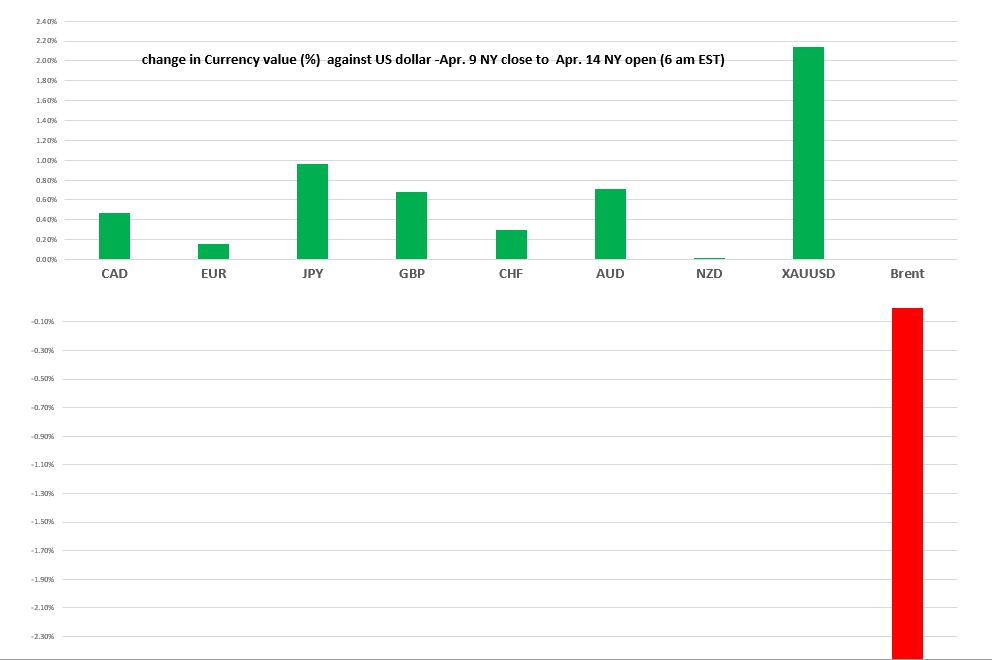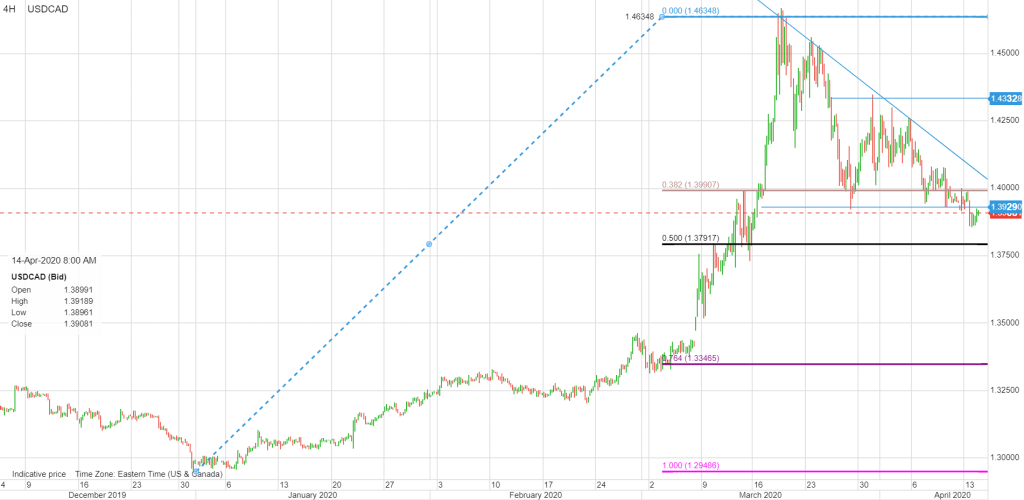
April 14, 2020
USDCAD open (6:00 am EST) 1.3908-12 Overnight Range 1.3865-1.3914
- Better than expected China trade data supports positive risk sentiment
- Oil prices fade massive production cut news
- American’s arguing about reopening the economy, and who has the “say-so” to proceed
- US dollar extends losses from Thursday’s NY close, opens with losses across the board
Chart: Currency gain/loss (%) against the US dollar from NY close to NY open (6:00 EST)

Source: Saxo Bank/IFXA
FX Recap and outlook: Thursday, Stats Canada announced that Canada lost over 1 million jobs in March and USDCAD sank. Who woulda thunk? The rest of the world was shedding jobs like a bachelor party entertainer sheds clothes, so Canada wasn’t anything special. It was a shift into risk-seeking assets that sparked the USDCAD sell-off, as talk about re-opening the US economy rippled across thin, holiday markets leading traders to unwind long US dollar COVID-19 safe-haven trades.
Chart: 30-minute USDCAD price action since April 9.

Source: Saxo Bank
WTI oil prices peaked at $28/10/barrel on Thursday as anticipation of an Opec/non-Opec production cut agreement squeezed short crude positions. In a text-book example of “buy the news, sell the rumour” trading WTI dropped to $21.71/b in Europe, today.
Opec announced crude oil production cuts of 10.0 mb/d, starting on 1 May 2020, until June 30, 2020, dropping to 8.0 mb/d from 1 July 2020 to 31 December 2020, and then falling again to 6.0 mb/d from January 1, 2021, to April 30, 2022.
Oil traders were not impressed as the cuts were not enough to sop up the existing excess supply from over-production and falling demand. Saudi Arabia is taking advantage of the May 1 start date, reportedly slashing their May official selling price by $4.20/b for Asian customers.
EURUSD consolidated Thursday’s gains and traded in a 1.0892-1.0965 range since Thursday’s NY close. Fed Chair Jerome Powell encouraged “risk-on” trading when he justified the Fed’s 2.3 billion stimulus package and said that “there is no limit to how much quantitative easing the Fed can do.” Prices were also underpinned by talk of American’s lifting pandemic restrictions. On the weekend, Minneapolis Fed President Neel Kashkari warned that the US recovery would likely be a long, hard road, suggesting an “18-month strategy of rolling shutdowns based on what has happened in other countries.”
GBPUSD climbed steadily since Thursday, supported by the improved risk environment, Powell’s comments, and chatter about the re-opening of the US economy. GBPUSD rose to 1.2575 from 1.2468 at Thursday’s NY close.
USDJPY dropped to 107.41 from 108.49, in part, because Japanese authorities just started the ball rolling on a COVID-19 fiscal stimulus package, even as US Treasury yields hover close to the top of their recent ranges.
AUDUSD and NZDUSD have pulled back from the overnight peak levels but continue to be supported by the Opec deal and by the better than expected China trade data.
There isn’t any economic data of note due today.
USDCAD technical outlook:
The intraday USDCAD technicals are bearish while prices are below 1.3950, looking for a revisit of the overnight low of 1.3865. A break above 1.3970 suggests a test of the April 6 downtrend line which comes into play at 1.4050. Longer term, the break below 1.4010 (38.2% Fibonacci retracement of 2020 range) targets 1.3605. For today, USDCAD support is at 1.3860 and 1.3810. Resistance is at 1.3970 and 1.4010. Today’s Range 1.3880-1.4070
Chart: USDCAD 4 hour

Source: Saxo Bank





